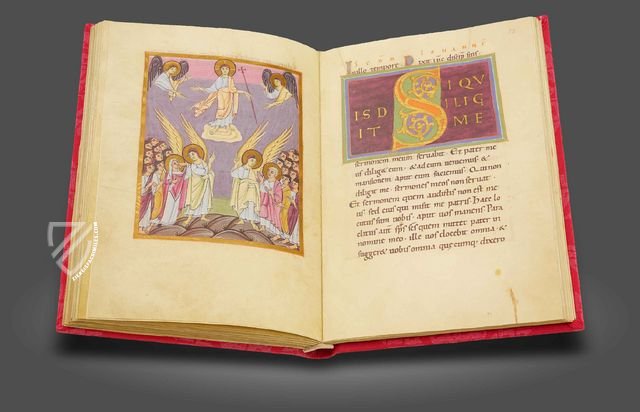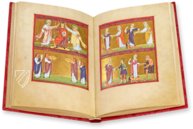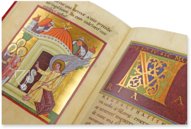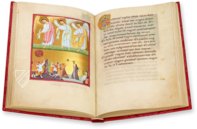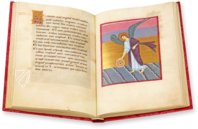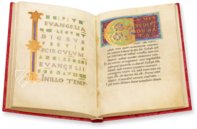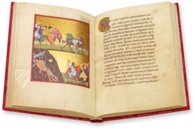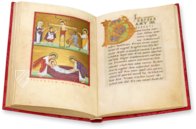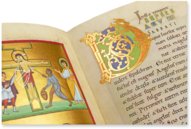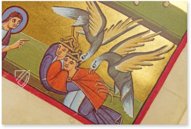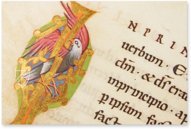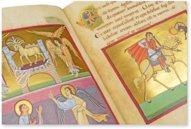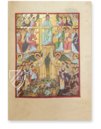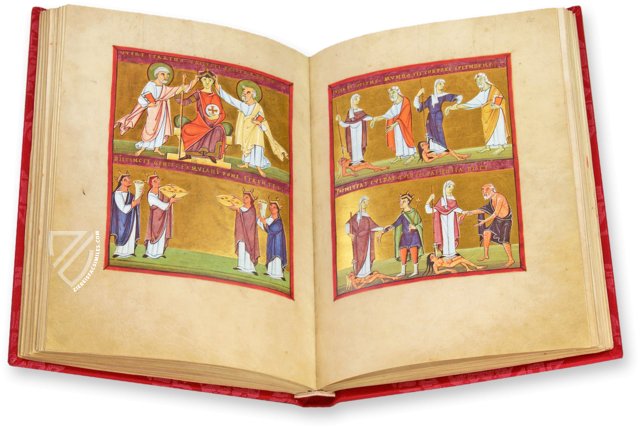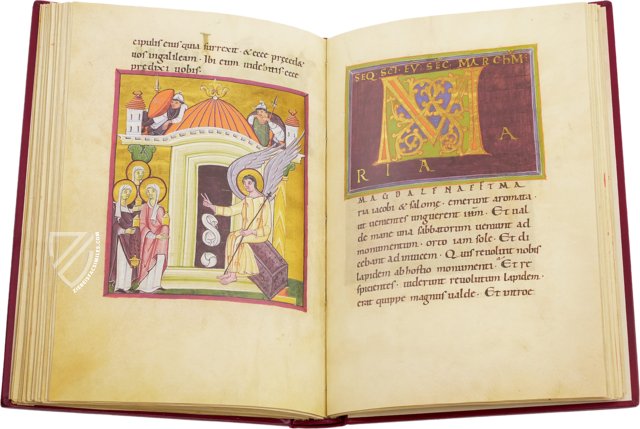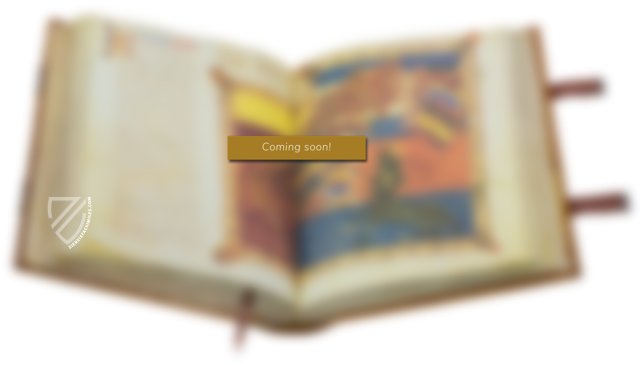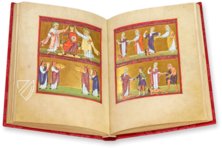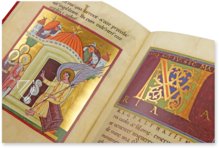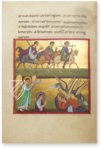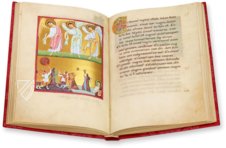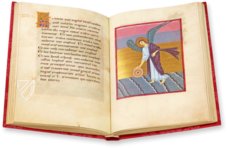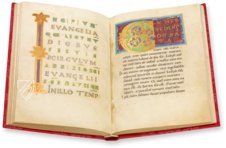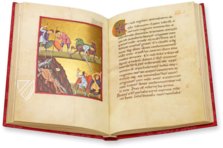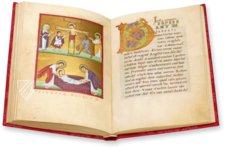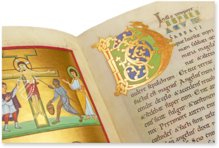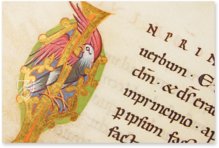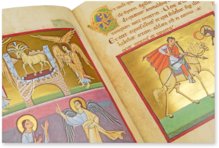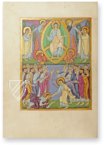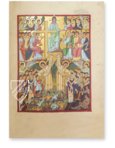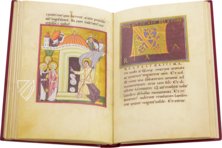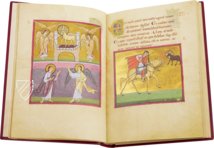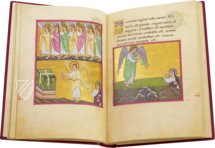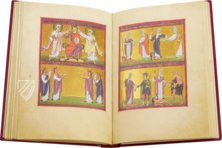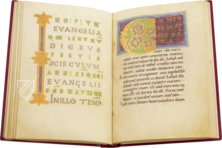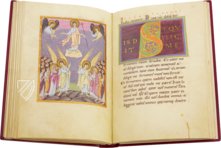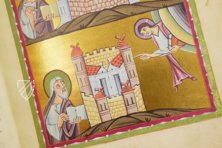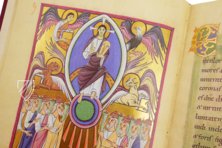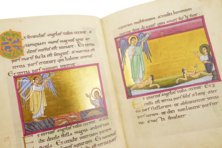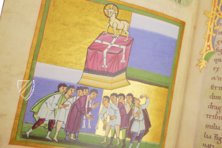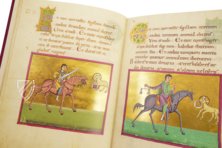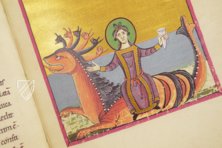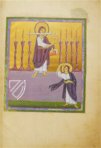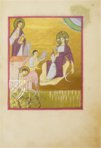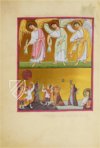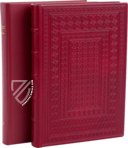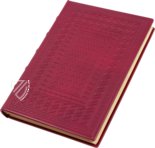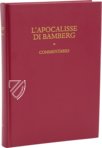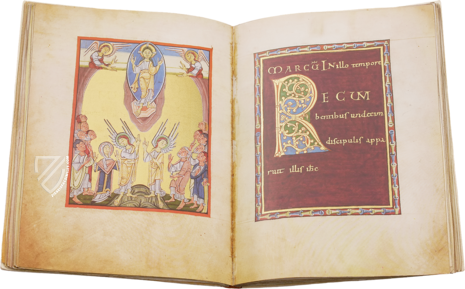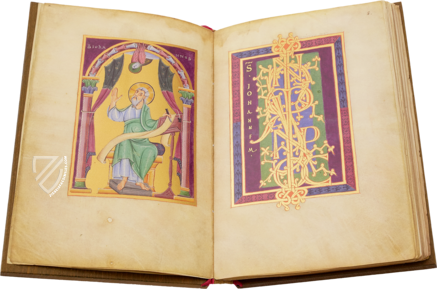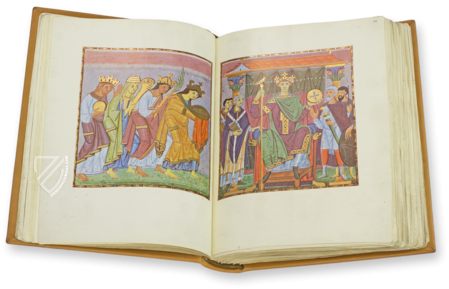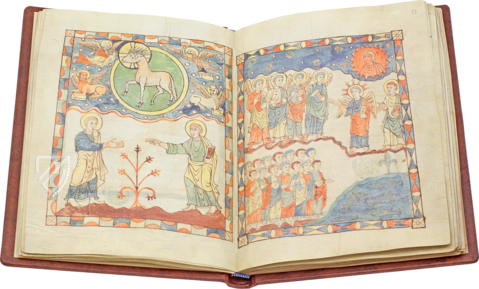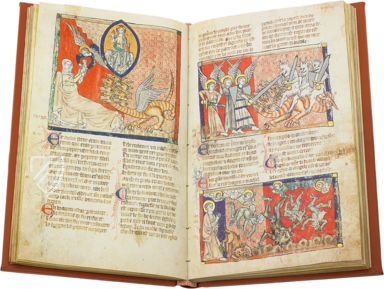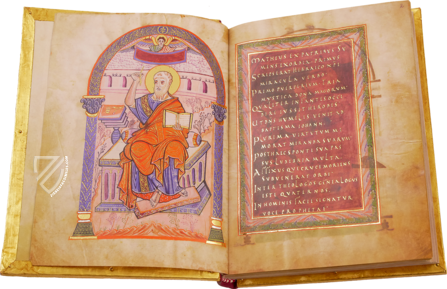Bamberg Apocalypse
(1,000€ - 3,000€)
A unique marvel of manuscript book art emerged from the scriptorium of the Reichenau Monastery between 1000 and 1020. The Bamberg Apocalypse, which has belonged to the UNESCO Memory of the World Programme since 2003, is the most famous and precious work of the Reichenau illuminators. It contains the only pictorial cycle of the Apocalypse that was produced by Ottonian illumination. The splendid, mostly full-page pictures on golden backgrounds possess and indescribable expressive power. The incomparable miniatures cast a spell on every beholder.
Bamberg Apocalypse
Among the numerous significant books and documents to be found in the Bamberg State Library, the Bamberg Apocalypse is a unique marvel of medieval book art. This illuminated manuscript counts among the most famous works from the scriptorium of the Reichenau Monastery and is the only work of Ottonian illumination that contains a pictorial cycle of the Apocalypse. The Apocalypse, also known as the Book of Revelation, the last book of the New Testament. The biblical text is a coherent allegorical composition full of significant symbols, which has shaped and fascinated the Christian community for centuries. This important text is illustrated in the Bamberg Apocalypse through a total of 57 splendid, large-format miniatures on a gold background. Initials richly adorned in gold and silver further ennoble the work.
A Mysterious Masterwork
To this day, uncertainty about the exact time of origin reigns over the historical research of the Bamberg Apocalypse. Paleographic findings as well as iconographic and style-critical assessments date the work to the period between 1000 and 1020. More difficult yet is the determination of who commissioned the splendid codex. A miniature in the manuscript shows a representative portrait of a sovereign, in which the commissioner is assuredly depicted. However, it has been a matter of controversial debate whether the sovereign figure is Kaiser Otto III or Kaiser Henry II. Presumably, the manuscript was commissioned at the behest of Otto, and remained incomplete after the ruler’s unexpected death at the age of 21. Otto’s successor, Henry II, probably discovered the precious codex in the Reichenau scriptorium and had it completed. Old literary traditions tell of a binding that no longer exists. This documented the donation of the codex by Kaiser Henry II and his wife Kunigunde to the Bamberg Collegiate Church of St. Stephen.
Fascinating Illumination
The Bamberg Apocalypse is the greatest and most famous work from the scriptorium of the Reichenau Monastery. The monastery was the seat of the foremost scriptorium artistically in the entire Holy Roman Empire. The exciting miniatures of the Apocalypse represent the only cycle for this book from the Bible that was produced in all of Ottonian illumination. Accompanying scenes in high-quality colors and precious gold backgrounds allow the book pages to shine in a unique luster. The intense pictures display a characteristic manner of presentation, in which the people and faces were illustrated with expressive facial expressions and gestures. Even centuries after their production, the expressive illustrations cast a spell on each of their beholders. Alongside the splendid, mostly full-page miniatures, ca. 103 decorative initials adorn the codex. The gold or silver letters find themselves against backgrounds of purple, blue, or green and are outlined by gilded arabesques, which open up in clover like formations or arrowheads. These special embellishments are considered to be the trademarks of the Reichenau book artists.
Codicology
- Alternative Titles
- Bamberger Apokalypse
L'Apocalisse di Bamberg - Size / Format
- 212 pages / 29.5 × 20.4 cm
- Origin
- Germany
- Date
- Around 1000–1020
- Epochs
- Style
- Language
- Illustrations
- 57 miniatures and 103 initials, some of them full-page
- Content
- Book of Revelation and a Lectionary
- Patron
- Otto III, Holy Roman Emperor (980–1002); Henry II, Holy Roman Emperor (972–1024)
- Artist / School
- Reichenauer Schule
Liuthar (illuminator) - Previous Owners
- St. Stephen's church, Bamberg
Bamberg Apocalypse
Christ on a White Horse
After the fall of Babylon, a rider on a white horse representing Christ is sent forth to lead the Heavenly Host against the Beast and his armies, who are utterly defeated. “Now out of His mouth goes a sharp sword, that with it He should strike the nations. And He Himself will rule them with a rod of iron. He Himself treads the winepress of the fierceness and wrath of Almighty God. And He has on His robe and on His thigh a name written: KING OF KINGS AND LORD OF LORDS.” (Rev. 19:15-16)"
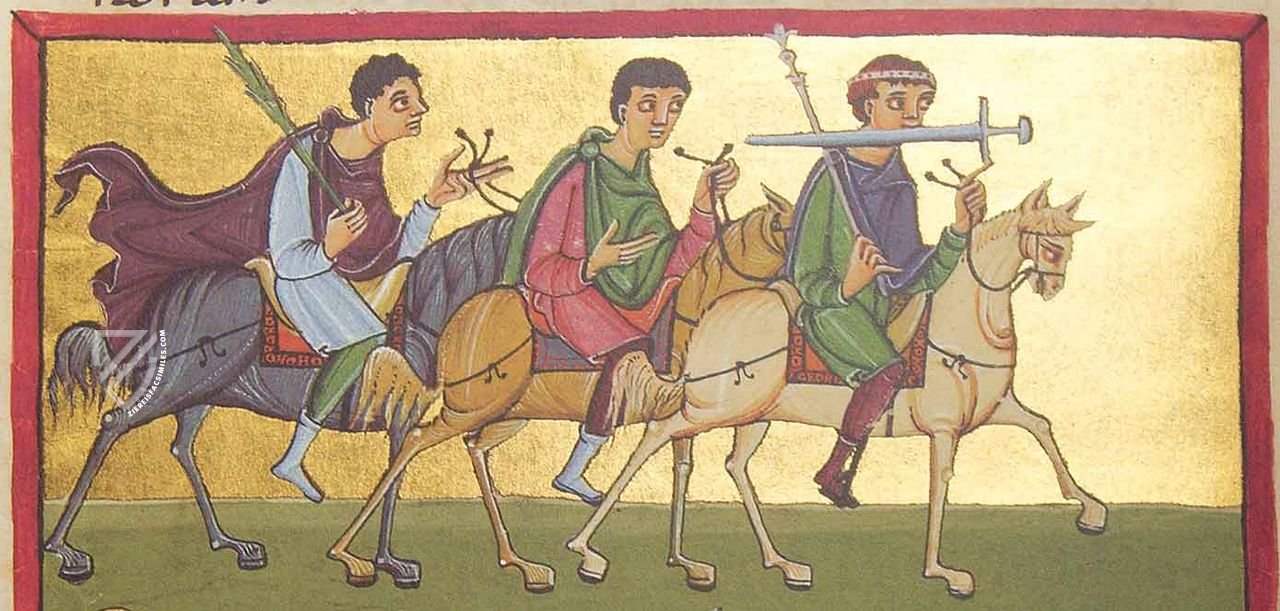
Bamberg Apocalypse
The Last Judgment
Here we see The Last Judgment, a beloved scene in Christian art. It is perfectly suited to the monumental style of Ottonian illumination with sublime figures set against a burnished gold background that seems timeless, spaceless, and eternal.
Christ is enthroned with a large cross, flanked by the Evangelists’ symbols, trumpeting angels, and the Twelve Apostles. His eyes look out over the beholder’s right shoulder, but all other eyes are on him, save for the two angels in white below, who look at the judged as they read their proclamations. The damned are in the bottom right corner where the Hellmouth and the naked, shackled denizens of Hell await them. The green-skinned dead arise, gesturing as though stretching after a long sleep, and look around in amazement.
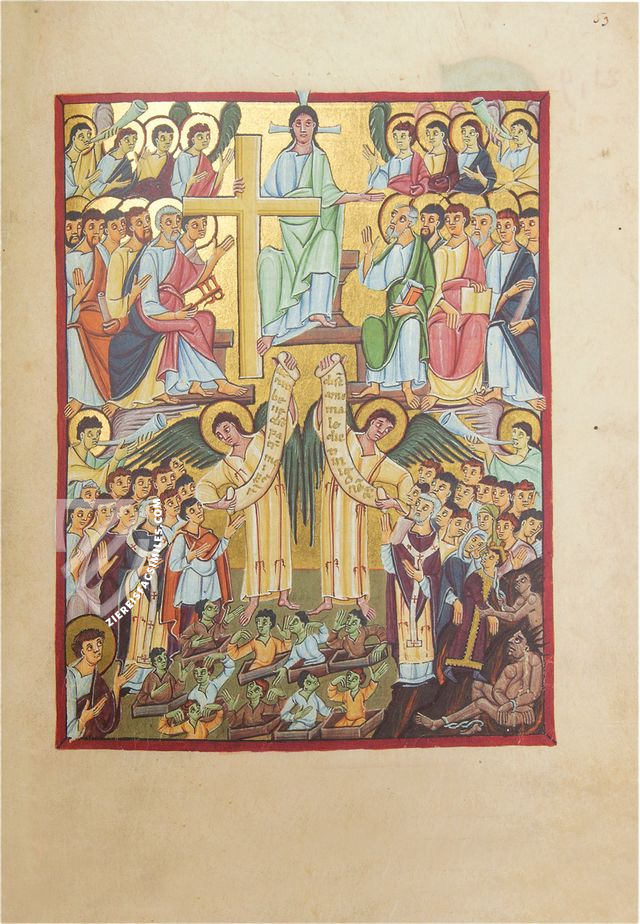
#1 Bamberger Apokalypse
Language: German
(1,000€ - 3,000€)
#2 L'Apocalisse di Bamberg
Language: Italian
(3,000€ - 7,000€)
#3 Ausgewählte Miniaturen der Bamberger Apokalypse
Language: German
(under 1,000€)
- Treatises / Secular Books
- Apocalypses / Beatus
- Astronomy / Astrology
- Bestiaries
- Bibles / Gospels
- Chronicles / History / Law
- Geography / Maps
- Saints' Lives
- Islam / Oriental
- Judaism / Hebrew
- Single Leaf Collections
- Leonardo da Vinci
- Literature / Poetry
- Liturgical Manuscripts
- Medicine / Botany / Alchemy
- Music
- Mythology / Prophecies
- Psalters
- Other Religious Books
- Games / Hunting
- Private Devotion Books
- Other Genres
- Afghanistan
- Armenia
- Austria
- Belgium
- Belize
- Bosnia and Herzegovina
- China
- Colombia
- Costa Rica
- Croatia
- Cyprus
- Czech Republic
- Denmark
- Egypt
- El Salvador
- Ethiopia
- France
- Germany
- Greece
- Guatemala
- Honduras
- Hungary
- India
- Iran
- Iraq
- Israel
- Italy
- Japan
- Jordan
- Kazakhstan
- Kyrgyzstan
- Lebanon
- Liechtenstein
- Luxembourg
- Mexico
- Morocco
- Netherlands
- Palestine
- Panama
- Peru
- Poland
- Portugal
- Romania
- Russia
- Serbia
- Spain
- Sri Lanka
- Sweden
- Switzerland
- Syria
- Tajikistan
- Turkey
- Turkmenistan
- Ukraine
- United Kingdom
- United States
- Uzbekistan
- Vatican City
- A. Oosthoek, van Holkema & Warendorf
- Aboca Museum
- Ajuntament de Valencia
- Akademie Verlag
- Akademische Druck- u. Verlagsanstalt (ADEVA)
- Aldo Ausilio Editore - Bottega d’Erasmo
- Alecto Historical Editions
- Alkuin Verlag
- Almqvist & Wiksell
- Amilcare Pizzi
- Andreas & Andreas Verlagsbuchhandlung
- Archa 90
- Archiv Verlag
- Archivi Edizioni
- Arnold Verlag
- ARS
- Ars Magna
- ArtCodex
- AyN Ediciones
- Azimuth Editions
- Badenia Verlag
- Bärenreiter-Verlag
- Belser Verlag
- Belser Verlag / WK Wertkontor
- Benziger Verlag
- Bernardinum Wydawnictwo
- BiblioGemma
- Biblioteca Apostolica Vaticana (Vaticanstadt, Vaticanstadt)
- Bibliotheca Palatina Faksimile Verlag
- Bibliotheca Rara
- Boydell & Brewer
- Bramante Edizioni
- Bredius Genootschap
- Brepols Publishers
- British Library
- C. Weckesser
- Caixa Catalunya
- Canesi
- CAPSA, Ars Scriptoria
- Caratzas Brothers, Publishers
- Carus Verlag
- Casamassima Libri
- Centrum Cartographie Verlag GmbH
- Chavane Verlag
- Christian Brandstätter Verlag
- Circulo Cientifico
- Club Bibliófilo Versol
- Club du Livre
- CM Editores
- Collegium Graphicum
- Collezione Apocrifa Da Vinci
- Comissão Nacional para as Comemorações dos Descobrimentos Portugueses
- Coron Verlag
- Corvina
- CTHS
- D. S. Brewer
- Damon
- De Agostini/UTET
- De Nederlandsche Boekhandel
- De Schutter
- Deuschle & Stemmle
- Deutscher Verlag für Kunstwissenschaft
- DIAMM
- Droz
- E. Schreiber Graphische Kunstanstalten
- Ediciones Boreal
- Ediciones Grial
- Ediclube
- Edições Inapa
- Edilan
- Editalia
- Edition Deuschle
- Edition Georg Popp
- Edition Leipzig
- Edition Libri Illustri
- Editiones Reales Sitios S. L.
- Éditions de l'Oiseau Lyre
- Editions Medicina Rara
- Editorial Casariego
- Editorial Mintzoa
- Editrice Antenore
- Editrice Velar
- Edizioni Edison
- Egeria, S.L.
- Eikon Editores
- Electa
- Emery Walker Limited
- Enciclopèdia Catalana
- Eos-Verlag
- Ephesus Publishing
- Ernst Battenberg
- Eugrammia Press
- Extraordinary Editions
- Fackelverlag
- Facsimila Art & Edition
- Facsimile Editions Ltd.
- Facsimilia Art & Edition Ebert KG
- Faksimile Verlag
- Feuermann Verlag
- Folger Shakespeare Library
- Franco Cosimo Panini Editore
- Friedrich Wittig Verlag
- Fundación Hullera Vasco-Leonesa
- G. Braziller
- Gabriele Mazzotta Editore
- Gebr. Mann Verlag
- Gesellschaft für graphische Industrie
- Getty Research Institute
- Giovanni Domenico de Rossi
- Giunti Editore
- Graffiti
- Grafica European Center of Fine Arts
- Guido Pressler
- Guillermo Blazquez
- Gustav Kiepenheuer
- H. N. Abrams
- Harrassowitz
- Harvard University Press
- Helikon
- Hendrickson Publishers
- Henning Oppermann
- Herder Verlag
- Hes & De Graaf Publishers
- Hoepli
- Holbein-Verlag
- Houghton Library
- Hugo Schmidt Verlag
- Idion Verlag
- Il Bulino, edizioni d'arte
- ILte
- Imago
- Insel Verlag
- Insel-Verlag Anton Kippenberger
- Instituto de Estudios Altoaragoneses
- Instituto Nacional de Antropología e Historia
- Introligatornia Budnik Jerzy
- Istituto dell'Enciclopedia Italiana - Treccani
- Istituto Ellenico di Studi Bizantini e Postbizantini
- Istituto Geografico De Agostini
- Istituto Poligrafico e Zecca dello Stato
- Italarte Art Establishments
- Jan Thorbecke Verlag
- Johnson Reprint Corporation
- Josef Stocker
- Josef Stocker-Schmid
- Jugoslavija
- Karl W. Hiersemann
- Kasper Straube
- Kaydeda Ediciones
- Kindler Verlag / Coron Verlag
- Kodansha International Ltd.
- Konrad Kölbl Verlag
- Kurt Wolff Verlag
- La Liberia dello Stato
- La Linea Editrice
- La Meta Editore
- Lambert Schneider
- Landeskreditbank Baden-Württemberg
- Leo S. Olschki
- Les Incunables
- Liber Artis
- Library of Congress
- Libreria Musicale Italiana
- Lichtdruck
- Lito Immagine Editore
- Lumen Artis
- Lund Humphries
- M. Moleiro Editor
- Maison des Sciences de l'homme et de la société de Poitiers
- Manuscriptum
- Martinus Nijhoff
- Maruzen-Yushodo Co. Ltd.
- MASA
- Massada Publishers
- McGraw-Hill
- Metropolitan Museum of Art
- Militos
- Millennium Liber
- Müller & Schindler
- Nahar - Stavit
- Nahar and Steimatzky
- National Library of Wales
- Neri Pozza
- Nova Charta
- Oceanum Verlag
- Odeon
- Orbis Mediaevalis
- Orbis Pictus
- Österreichische Staatsdruckerei
- Oxford University Press
- Pageant Books
- Parzellers Buchverlag
- Patrimonio Ediciones
- Pattloch Verlag
- PIAF
- Pieper Verlag
- Plon-Nourrit et cie
- Poligrafiche Bolis
- Presses Universitaires de Strasbourg
- Prestel Verlag
- Princeton University Press
- Prisma Verlag
- Priuli & Verlucca, editori
- Pro Sport Verlag
- Propyläen Verlag
- Pytheas Books
- Quaternio Verlag Luzern
- Reales Sitios
- Recht-Verlag
- Reichert Verlag
- Reichsdruckerei
- Reprint Verlag
- Riehn & Reusch
- Roberto Vattori Editore
- Rosenkilde and Bagger
- Roxburghe Club
- Salerno Editrice
- Saltellus Press
- Sandoz
- Sarajevo Svjetlost
- Schöck ArtPrint Kft.
- Schulsinger Brothers
- Scolar Press
- Scrinium
- Scripta Maneant
- Scriptorium
- Shazar
- Siloé, arte y bibliofilia
- SISMEL - Edizioni del Galluzzo
- Sociedad Mexicana de Antropología
- Société des Bibliophiles & Iconophiles de Belgique
- Soncin Publishing
- Sorli Ediciones
- Stainer and Bell
- Studer
- Styria Verlag
- Sumptibus Pragopress
- Szegedi Tudomànyegyetem
- Taberna Libraria
- Tarshish Books
- Taschen
- Tempus Libri
- Testimonio Compañía Editorial
- Thames and Hudson
- The Clear Vue Publishing Partnership Limited
- The Facsimile Codex
- The Folio Society
- The Marquess of Normanby
- The Richard III and Yorkist History Trust
- Tip.Le.Co
- TouchArt
- TREC Publishing House
- TRI Publishing Co.
- Trident Editore
- Tuliba Collection
- Typis Regiae Officinae Polygraphicae
- Union Verlag Berlin
- Universidad de Granada
- University of California Press
- University of Chicago Press
- Urs Graf
- Vallecchi
- Van Wijnen
- VCH, Acta Humaniora
- VDI Verlag
- VEB Deutscher Verlag für Musik
- Verlag Anton Pustet / Andreas Verlag
- Verlag Bibliophile Drucke Josef Stocker
- Verlag der Münchner Drucke
- Verlag für Regionalgeschichte
- Verlag Styria
- Vicent Garcia Editores
- W. Turnowski Ltd.
- W. Turnowsky
- Waanders Printers
- Wiener Mechitharisten-Congregation (Wien, Österreich)
- Wissenschaftliche Buchgesellschaft
- Wissenschaftliche Verlagsgesellschaft
- Wydawnictwo Dolnoslaskie
- Xuntanza Editorial
- Zakład Narodowy
- Zollikofer AG

